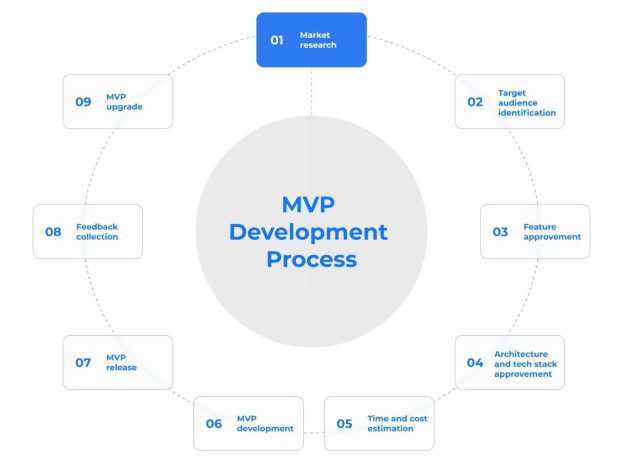Embarking on a business idea requires thorough validation, particularly in the realm of digital products, where what seems promising on paper might not translate into a successful and worthwhile investment. This holds especially true for software startups. Thankfully, there exists a cost-effective method to assess the viability of a potential product.
Software developers can construct a rudimentary version of the envisioned software product, akin to creating small-scale models for engineering concepts. This process, known as “building an MVP” (Minimum Viable Product), has become a standard practice in software development due to its myriad benefits. Let’s delve into the details of MVP software engineering.
What is MVP in Software Development?
In the realm of software development, “MVP” stands for “Minimum Viable Product,” representing a functional iteration of a future software product that showcases its core concept and basic functionality.
Components of MVP Development
In the context of MVP development, “minimum” denotes the number of included features, “viable” signifies readiness for the market and adequacy for early adopters, and “product” implies tangible user access to a solution through devices. An MVP in software development should possess three critical components:
Goals and Objectives of an MVP
The goals and objectives of a Minimum Viable Product (MVP) revolve around the idea of quickly delivering a functional version of a product to gather feedback and validate assumptions. Here are the key goals and objectives of an MVP:
1. Validate Assumptions
- Goal: Confirm whether the assumptions about user needs, problems, and solution hypotheses are accurate.
- Objective: Gather feedback from real users to verify that the product addresses a genuine need.
2. Minimize Time to Market
- Goal: Launch the product quickly to gain a competitive edge and start learning from real user interactions.
- Objective: Develop and release the MVP with essential features in a timely manner.
3. Learn and Iterate
- Goal: Continuously improve the product based on user feedback and evolving market conditions.
- Objective: Establish a feedback loop, analyze user data, and iterate on the product to enhance its features and user experience.
4. Reduce Development Costs
- Goal: Avoid unnecessary development expenses by focusing on essential features.
- Objective: Develop only the core features required to test the product’s viability and gather feedback, minimizing unnecessary development efforts.
5. Identify Market Fit
- Goal: Determine whether the product resonates with the target audience and meets their expectations.
- Objective: Measure user satisfaction, engagement, and other relevant metrics to assess the product’s market fit.
6. Prioritize Features
- Goal: Identify and prioritize features based on user feedback and actual usage patterns.
- Objective: Use early user feedback to determine which features are most valuable and should be enhanced or added in future iterations.
7. Mitigate Risk
- Goal: Reduce the risk of investing significant resources in a full-featured product that may not meet market demands.
- Objective: Test the riskiest assumptions early in the development process and adjust the product strategy based on validated learning.
8. Build a User Base
- Goal: Attract early adopters and start building a user base.
- Objective: Launch the MVP to a targeted audience, gather initial users, and create a foundation for future growth.
9. Align with Business Objectives
- Goal: Ensure that the MVP aligns with the overall business strategy and objectives.
- Objective: Define clear business goals for the MVP, such as customer acquisition, revenue generation, or market validation.
10. Optimize Resource Allocation
- Goal: Allocate resources efficiently by focusing on what matters most to users.
- Objective: Analyze user feedback and data to make informed decisions about where to allocate development resources for maximum impact.
11. Enhance Investor Confidence
- Goal: Increase confidence among investors by demonstrating progress and user acceptance.
- Objective: Share positive feedback, user metrics, and insights gained from the MVP to showcase the potential success of the product.
By aligning these goals and objectives, an MVP provides a strategic approach to product development that maximizes learning, minimizes risks, and sets the stage for building a successful and sustainable product.
MVP Development Process

MVP Development Process
The MVP development process, a streamlined version of conventional software development, involves analytical, building, and post-release stages:
- Market Research: Understand the dynamics of the IT market and evaluate idea feasibility.
- Identify Target Audience: Create an ideal customer profile based on market research.
- Define Features: Determine a set of features aligned with user expectations.
- Choose Architecture and Tech Stack: Plan architecture and select the best-fit technology stack.
- Estimate Time and Cost: Assess the development team’s size, composition, and project costs.
- Create MVP: Develop a usable build, involving designers, developers, testers, and specialists.
- Release MVP: Introduce the MVP to the market or a focus group.
Benefits of an MVP
The unique format of an MVP offers several advantages:
- Market Knowledge: Obtain insights into market demand and consumer needs.
- Feasibility Validation: Confirm the implementability of the business concept.
- Cost and Speed Efficiency: Accelerate time-to-market with reduced development costs.
- Investor Attraction: Presenting a functional product enhances the appeal to potential investors.
- Early Feedback: Gather valuable user feedback for refining the final product.
Conclusion
Creating an MVP serves as a potent strategy for startups, showcasing commitment, mitigating risks, and attracting investor interest. Intellectsoft provides comprehensive MVP software development services to propel your concept toward becoming a fully realized product. Contact us, and we’ll transform your idea into a market-ready MVP.